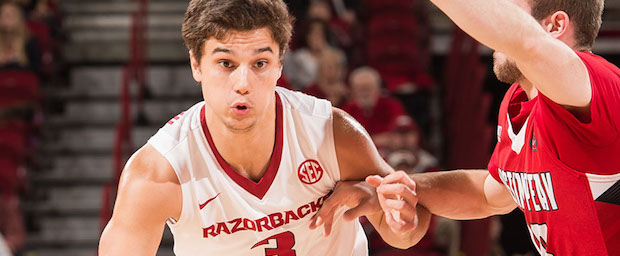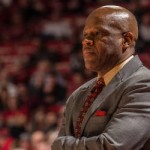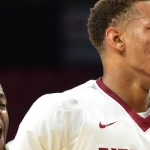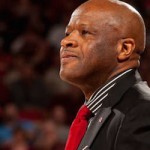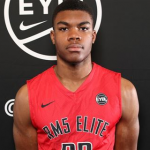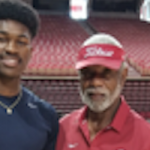 If you thought the sleeping giant that is Arkansas Razorback basketball team had finally been awakened in Mike Anderson’s 4th season — 27 wins, 2nd-place finish in the SEC and SEC Tournament, return to the NCAA Tournament with a 5-seed, and a final Top 20 ranking in 2014-15 — you had to hold that thought during year 5 which saw 8 pre-season departures/suspensions (only 2, arguably 3, of those were expected) that led to a backslide to 16-16 (9-9 SEC) in ’15-’16.
If you thought the sleeping giant that is Arkansas Razorback basketball team had finally been awakened in Mike Anderson’s 4th season — 27 wins, 2nd-place finish in the SEC and SEC Tournament, return to the NCAA Tournament with a 5-seed, and a final Top 20 ranking in 2014-15 — you had to hold that thought during year 5 which saw 8 pre-season departures/suspensions (only 2, arguably 3, of those were expected) that led to a backslide to 16-16 (9-9 SEC) in ’15-’16.
But, was it really a backslide or just a speed bump? I say speed bump, but let’s see where the Hogs currently stand in 2016-17 — year 6 of the Mike Anderson era.
Through 7 games, Arkansas is 6-1 and currently ranked No. 22 in the college basketball RPI (at the time of this writing). Ratings Percentage Index, of course, is one of the tools the NCAAT selection committee uses to determine its Dance at-large invitees. It’s just one slice of the criteria, but smart scheduling gives the Hogs respectable (albeit early) RPI footing with 20% of the season already in the books. But it’s only one look/perspective from a formula that gets jumbled, jostled, and simulated by computers every day.
The eye test, which will also factor in come March when NCAAT invites are handed out, doesn’t tell us much … at all, yet. The Hogs’ early journey to 6-1 is good but still leaves us with far more questions than answers.
Following the Hogs’ second exhibition game last month, I asked Mike Anderson if his 6-deep corps of guards was his toughest, most physical backcourt since returning to Fayetteville. With four games in Spain, a Red-White game, and two exhibition games in the books, I thought maybe he’d seen enough to bite on that question. “Too early, we’ll see” he said. “Remember to ask me that again later” was his suggestion to me.
And that answer would almost fit perfectly for any global, big-picture question about this team through 7 regular-season games. Especially the biggest question: Does this look like an NCAAT team? The talent, depth, experience, and coaching are there. But with 7 newcomers still acclimating and bonding with 5 veteran returnees, plus the uncertainty this early in the season about the quality of Arkansas’s future opponents, we’re all still in searching-for-answers mode.
The Razorbacks got out of the gates the right way at 3-0 against the likes of strong mid-majors Fort Wayne (knocked off No. 3 Indiana) and UT-Arlington (defeated Texas for the first time ever), then traveled to Minnesota for their first road game against the Big 10’s Gophers. The resounding THUD that could be heard and felt back here in Arkansas was from the long and hard fall the Hogs’ suffered while playing bad basketball at both ends of the floor in an 85-71 loss that looked much worse than the final score.
So with those 7 newcomers and 5 returnees, Mike Anderson decided to shuffle the starters and substitution-rotations in the subsequent 3 home games played over 6 days last week — all convincing wins over Mount St. Mary’s, Stephen F. Austin, and Austin Peay. I was at Bud Walton Arena for MSM and SFA but missed the 99-62 win over Austin Peay.
What I see right now is a team searching for an identity, a floor leader, and consistency at both ends of the court but especially on defense The Hogs are not unlike so many teams in college basketball who are still fumbling through some issues while getting better day-by-day, game-by-game, but we just don’t know yet which trouble-areas will improve and by how much, and which ones will stubbornly stick with the Hogs through 31 games.
Arkansas has struggled on-and-off already with: Giving up offensive rebounds / second-chance points; forcing turnovers (only one game so far where the Hogs forced 20 or more TOs); suffering their own unforced turnovers (the 21 turnovers at MN were awful, but the turnover bug has been an issue in several games this season); more good ball movement/spacing and less over-dribbling on offense; and 3-point shooting efficiency. I’ve seen some two-steps-forward-one-step-back in regards to working through these issues, and I believe the Hogs are moving in the right direction.
What concerns me most right now is poor communication, timing, and execution on defense. Not all of the problems persist throughout every game and it’s too early to say this team won’t be good defensively — they have held 4 of their 7 opponents to sub-40% field-goal shooting — but poor communication, timing and execution have all conspired to affect a defense that struggles during large portions of games. Switching ball-screens, finding or closing out on shooters at the 3rd level, help rotations, hedging/recovery, on-ball defenders using hands more than feet which leads to fouls and/or blow-by’s. The Hogs have resorted to a 2-3 zone at times which has been effective, but that is a small band-aid in this system. Mike Anderson preaches defense first, so you know he and the staff are working hard to repair or at least minimize these issues while finding the right personnel combinations to maximize the depth, length, and athleticism that last year’s poor defensive team did not have.
Individually, Moses Kinglsey has struggled early. The 6-10 senior picked to be SEC Player of the Year surely misses having a true, facilitator-first point guard like Jabril Durham, who made it a priority to get Moses involved early and often last year. But Moses has to be more assertive offensively. This year’s guards certainly are assertive offensively, so Mo’s got to demand the ball in the low post and finish better through contact while being more proactive and less reactive when the double-team comes. Conversely, Moses has been a prolific shot-blocker and disruptive force inside consistently, and his free-throw shooting has improved from last season, so when the offense does pick up for him he very well could be in line for the All SEC 1st team season that is expected. Right now, his scoring (10.4 points compared to 15.9 a year ago), rebounding (7.9 compared to 9.3 a year ago), and field-goal percentage (46.2% compared to 54.8% a year ago) are all down, but his shot-blocking (3.3 compared to 2.4 a year ago), assists (2.1 compared to 1.2 a year ago) and free-throw shooting (77.4% compared to 63.7% a year ago) are all up. Also returning in the frontcourt is 6-9 junior Trey Thompson, who is a productive per-minutes rebounder and serviceable backup in the low post to Kingsley, but skilled enough to be a passing weapon from the high post.
Looking at the backcourt returnees, Dusty Hannahs is a fringe All SEC caliber player (Top 10 scorer in the league last season) who has struggled with his 3-point efficiency early on, but he shows time and time again he won’t be defined by the 3-point line. Hannahs can score from every angle at all 3 levels in the halfcourt, and he gets to the free throw line with regularity while shooting at a 90ish% clip when he gets there. He’s leading the team in scoring at 16.1 points per game.
Returning veteran guards Manuale Watkins and Anton Beard are both improved from a season ago, which is very encouraging. Manny is the glue-guy for this team who is limited offensively but is an efficient shooter in and around the lane (56.8% FGs); he’s the kind of player who can lead your team in rebounds (3.9 average is second on the team), assists, or steals in any given game. Beard is a junior combo-guard who has been the team’s best and most efficient facilitator going back to the Spain summer exhibition tour. He’s been productive and efficient playing mostly off the bench, averaging 8.6 points while shooting 40% from 3-point range (best among the guards who have at least 15 attempts), but more importantly he’s averaging a team-best 3.3 assists and only 0.9 turnovers per game.
That core of 5 returning veteran players is solid, a good foundation for a return to the NCAAT, but the newcomers will determine if the Hogs make travel plans as a team in mid-March. It starts with the two 6-foot-3 juco-transfer guards, Jaylen Barford and Daryl Macon. Both guards are fearless slashers on offense, both have skill and talent, and both could end up a fantastic duo defensively. Macon is already a plus-defender, and Mike Anderson has raved about Barford’s lateral movement and ability to stay in front of his man defensively. In the early going, Barford (11.6 points) and Macon (10.6 points) are averaging double-figures scoring and are 2nd and 3rd on the team in scoring average. So, offense and defense are not going to be problems for these two, but turnovers have been a problem as they acclimate to the system and the strengths/weaknesses of their teammates.
Junior-transfer 6-7 Dustin Thomas has been an upgrade at the power forward position as a starter, showing skill offensively and tenacity defensively, but he’s working through fouling and turnover issues in the early part of the season. Juco-transfer forward Arlando Cook has flashed some promise, but needs to be a more productive rebounder and take care of the ball better when he’s on the floor. Freshman C.J. Jones, 6-5 with good length and athleticism, has missed some time early on with a knee injury, but he’s an efficient volume shooter-scorer when his number is called. Freshman combo forward Adrio Bailey has elite athleticism at 6-6 and is starting to come on of late. Brachen Hazen is a skilled 6-8 stretch-4 freshman who needs to continue to add bulk/strength in the weight room before being a major factor on this team.
When I look at the individual pieces and early team dynamics, then factor in a very small sample size of meaningful games against quality opponents to this point, my crystal ball is far from clear and speculation is all I have. We’ll know more in a couple of weeks after Arkansas has faced a couple of solid non-conference foes in Houston (current RPI No. 60) at home on Tuesday, and Big 12 Texas at a neutral site on Dec. 17.
As for now, I’m won’t avoid answering the big question but I’m also not ready to make predictions: Does this look like an NCAAT team? Yes, from a talent, depth, experience, and coaching standpoint, all the pieces are there. I think this team is good enough to win 22-24 games in the regular season, and if the RPI stays in the 20-to-40 range, that would surely be enough for them to Dance again in ’16-’17. But I don’t believe it yet. Too many unknowns right now to predict with full confidence a return to the NCAAT come March.
If it happens, Mike Anderson will have 2 NCAAT teams in the past 3 seasons and 3 NIT/NCAAT teams in the past 4 seasons — all following a 5-year post-season drought in the program — with a couple of strong recruiting classes either signed (2017) or committed (2018) that appear ready to help move the needle even more in the right direction.
Then we’ll all say last season was just a speed bump while pointing to the sleeping giant who has both eyes opening with one foot on the floor and the other about to drop … causing a THUD that can be heard and felt as far north as Minnesota!
* * *
Kevin McPherson is a former sportswriter and editor at both the Arkansas Gazette and Arkansas Democrat, as well as a former contributor to newspapers in Northwest Arkansas — covering Arkansas Razorbacks basketball, high school football and basketball, and basketball recruiting. He’s entering his 13th year as a mortgage banker with Bank of England, but he still covers Razorback basketball and recruiting as well as high school sports. You can join him live every Monday and Thursday at 1:30 CST on The Hog Call, KREB 1190 The Fan in Northwest Arkansas by clicking here: http://1190thefan.com/listen-live/ You can also follow him live on Twitter @ARHoopScoop.


